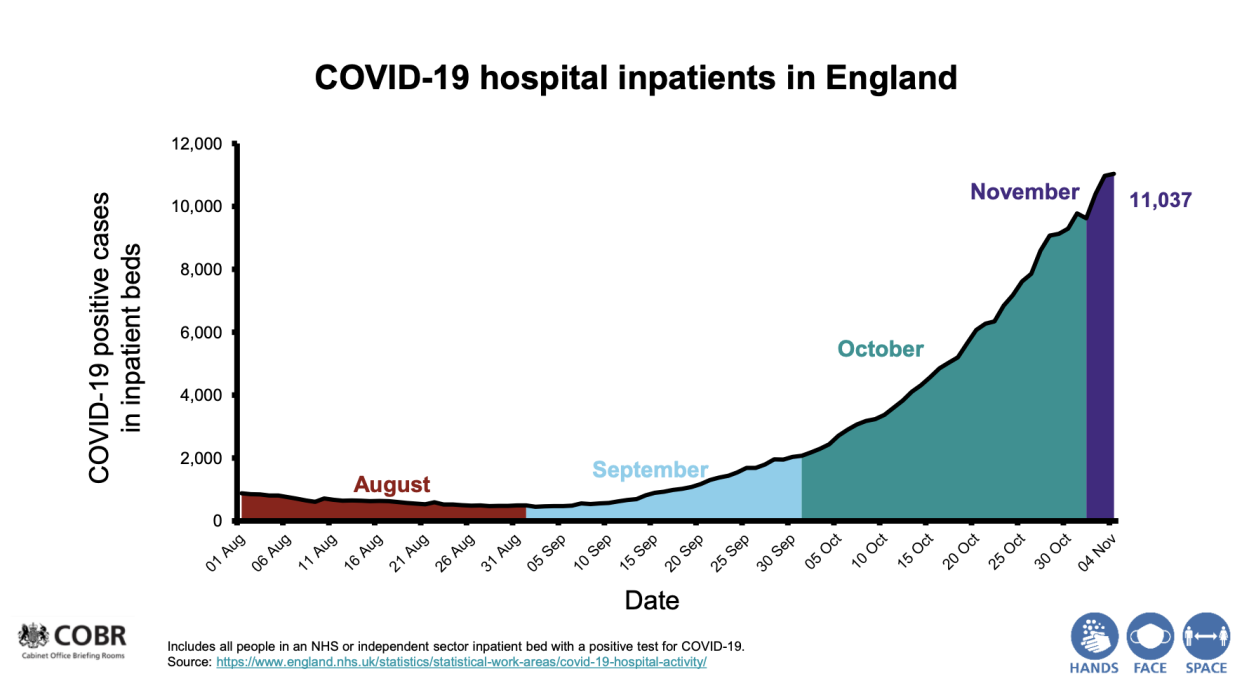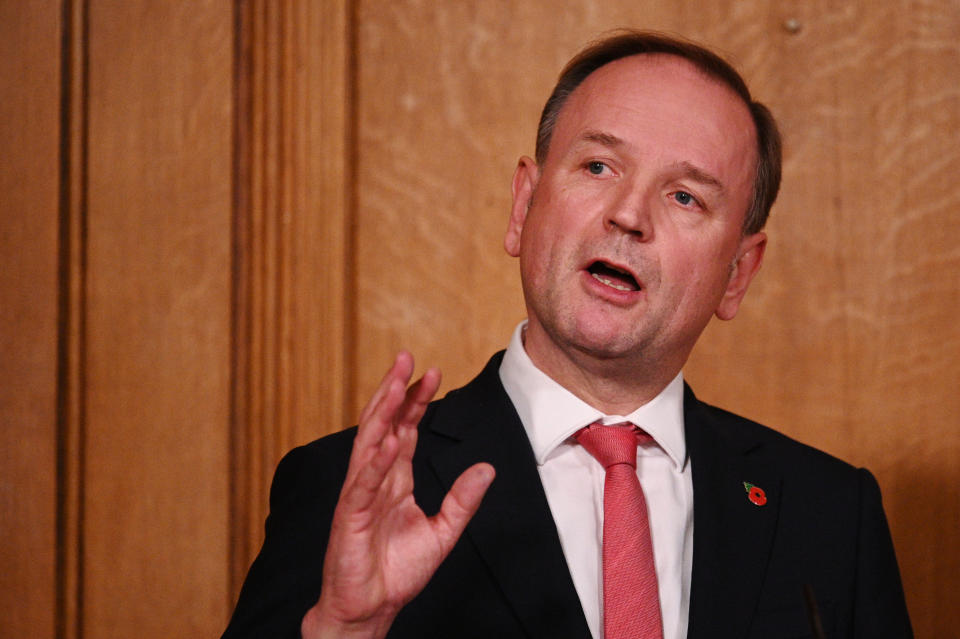COVID-19: The one chart the head of the NHS wants you to see


The head of the NHS has said he wants the nation to see “just one chart” that “indisputably” shows how bad the second wave of coronavirus is in the UK.
During a Downing Street press conference hosted by Prime Minister Boris Johnson, NHS Chief Executive Sir Simon Stevens shared a graph that showed the steep rise in coronavirus hospital admissions the nation has seen since August.
The graph showed there were below 500 patients with coronavirus in hospital in late August but has since risen to a high of 11,037 on 4 November.
Sir Simon said the number of people in hospital right now with coronavirus is the equivalent of 22 full English hospitals.
Watch: NHS chief executive: Coronavirus vaccination unlikely until 2021
He said: “Those are facts those are not projections, forecasts or speculation, those are patients in hospital today.”
Sir Simon said: “11,000 coronavirus patients that we have got in hospital compares with 3,000 patients that we would typically have in hospital on any one day during a very bad winter flu season, for flu.
“It compares with about 7,000 patients who’d be in hospital today being looked after for cancer.”
Sir Simon pointed out there was a lag between seven to 10 days of getting infected before needing to go hospital and between 15-30 days total before a person is either discharged or dies to the illness.
This means the nation can expect hospital numbers to continue to rise while England enters into lockdown.

He added around 30,000 staff in the health service were either off with coronavirus or having to self-isolate, and “that has an impact”.
That underlined the need to control the spread of coronavirus in order to protect the care that could be offered in the NHS, he said.
“Our success in controlling community transmission of coronavirus also is a force multiplier, to what the NHS itself can then provide in the way of care,” he said.
Sir Simon said he wanted the nation to understand three points that he believed all people working in the health service wanted the whole population to know.
These were:
This second wave is real and serious
The health service has been working hard to plan and prepare for a second wave
The ability of the NHS to continue to operate is dependent on people following the rules
On the final point Sir Simon emphasised it by quoting an intensive care doctor he had recently had a conversation with.
Quoting Doctor Allison Pittard, Sir Simon said: “In the here and now we can’t stop cancer developing, in the here and now we immediately prevent heart attacks or strokes and hospitals, of course, has got to respond to those.
“But we can reduce the spread of coronavirus in the community and that is what we need to do to be able to care for everybody who needs it.”
A recent YouGov poll showed 61% of Britons are confident the NHS has the capacity to handle the coronavirus over winter, despite reports it had been given £1bn less than it needs.
Read more: Global COVID daily deaths set to outstrip first wave within days
The majority of Britons (61%) are confident that the NHS has the capacity to handle coronavirus over winter, despite reports that it has been given in excess of £1bn less than it needs to tackle the second wave https://t.co/YeHxwHokKQ pic.twitter.com/5gUW4PkvOF
— YouGov (@YouGov) November 5, 2020
Boris Johnson said at the press conference the four-week coronavirus lockdown in England will be enough to have a “real impact” on the spread of the disease.
The prime minister said that while many people were “anxious, weary and fed up” the measures were strictly time-limited.
“The advice I have received suggests that four weeks is enough for these measures to make a real impact,” he said.
Read more: Fears new ‘prison-style’ care home rules will leave vulnerable people distressed

He said the rules would expire on 2 December and that “there is light at the end of the tunnel.”
He added: “These are difficult times. While it pains me to have to ask once again for so many to give up so much, I know we can get through this.”
England entered into a second lockdown on Thursday with all pubs, bars, restaurants and non-essential shops closed.
Schools and universities have been allowed to remain open, but strict social distancing measures are in place.
Cases have continued to rise across England in recent weeks and there have been warnings hard-hit areas in the North could run out of space in their hospitals.
Some 137,180 people tested positive for coronavirus in England in the week to 28 October, an increase of 8% compared to the previous week.
There were 492 deaths from COVID-19 in the UK on Wednesday the highest since 19 May.
Coronavirus: what happened today
Click here to sign up to the latest news and information with our daily Catch-up newsletter

 Yahoo News
Yahoo News 
